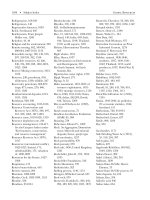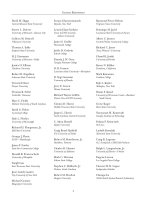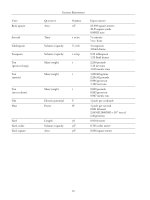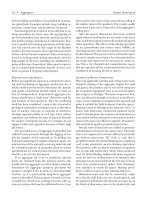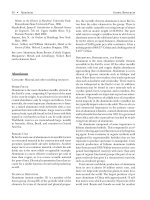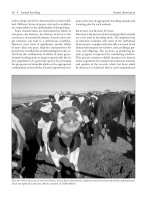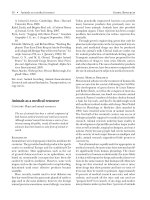Encyclopedia of Global Resources part 8 pptx
Bạn đang xem bản rút gọn của tài liệu. Xem và tải ngay bản đầy đủ của tài liệu tại đây (275.17 KB, 10 trang )
and to a large extent the characteristics or traits exhib
-
ited. Different forms of genes, referred to as alleles,
are responsible for the individuality of living things.
Some characteristics are determined by alleles of
one gene—for instance, the absence of horns or the
occurrence of a metabolic disease. In such cases a sin-
gle mutation can lead to a deleterious condition.
However, most traits of significance involve alleles
of more than one gene. Superior characteristics for
growth rate or milk yield,so-calledpolygenic traits, re-
sult from the combination of alleles of many genes.
Animal breeding seeks to improve genetically the fu-
ture population of a particular species by increasing
the proportion of desirable alleles or the appropriate
combination of such alleles.Geneticimprovementre-
quires selection of appropriate breeding animals and
a mating plan for such animals.
Selection and Mating Systems
Selection is theprocess of determining which animals
are to be used as breeding stock. The simplest form
of selection considers only traits of the individual,
whereas more complex selection takes account of ad-
ditional information on relatives, such as siblings, par-
ents, and offspring. The accuracy of predicting ge-
netic progress is improved by considering relatives.
This process requires reliable measures for desired
traits, acquisition of records from numerous animals,
and analysis of the records, which has been aided
by advances in statistical theory and computational
40 • Animal breeding Global Resources
Since the 1940’s, dairy cows in the United States, such as these in Sacramento, California, have been intensively bred for milk production,
which has tripled since that time. (Photo courtesy of USDA NRCS)
power. The result is a ranking of animals based on
their genetic merit for single or multiple traits.
Several systemshave been used for mating selected
animals. One involves complementarity, whereby in-
dividuals with high genetic merit for different traits
are mated. Ithas been used toimprove livestock in de-
veloping countries by mating animals adaptedtolocal
conditions with highly productive ones from devel-
oped countries. The beefcattle, swine, and poultry in-
dustries make heavy use of crossbreeding, in which
animals from different breeds are mated. One of its
advantages is the “hybrid vigor” that results. Another
system is mating the best to the best. Oneofitshazards
is inbreeding, or the mating of relatives, which often
results in decreased fertility and viability.
Environmental Factors
Performance or productivity is determined not only
by genetics but also by environmental factors. Cli-
mate, nutrition, and management can affect the ex-
tent to which the genetic potential of an animal is real-
ized. Because the productivity of an animal can be
affected deleteriously by heat and disease, climate
and other environmental factors can influence ani-
mals’ performance. Similarly, the management sys-
tem used, whether intensive or extensive, can also af-
fect productivity. Accordingly, the most productive
animal under one set of conditions may not necessar-
ily be the most productive under another. Interac-
tions between genetics and the environment must be
considered in animal breeding.
Post-1940’s Developments
Beginning in the mid-twentieth century, reproduc-
tive technologies, most notably artificial insemina-
tion, contributed to rapid improvement in animal
performance. These technologies permit animals with
the best genetics to be used widely, resulting in nu-
merous offspring from which to select the best breed-
ing stock for the next generation. As a result of inten-
sive selection and management in the United States
beginning in the 1940’s, milk production per cow has
more than tripled. The growth rate of chickens has
more than doubled, as has egg production. Such
increases have occurred concurrently with a higher
efficiency in raising animals for human food.
Molecular biology and biotechnology hold the po-
tential to alter animal breeding processes significantly
in the early twenty-first century. Further understand
-
ing of the genomes of livestock species should permit
identification of specific genes that will increase the
productivity of these animals. One approach, known
as marker-assisted selection, would use genetic mark-
ers associated with desirable production characteris-
tics to enhancegenetic improvement. If suchmarkers
prove to be accurate predictors, they will allow selec-
tion of desirable animals long before performance
records are available. Transfer of desirable genes,
within or between species, may also expedite the gen-
eration of superior animals. The goal of animal breed-
ing can be expected to remain similar to that of the
past—namely the improvement of animal species to
better meet human needs—but the precise nature of
the improvements desired and the methodologies
used to achieve them could be vastly different.
James L. Robinson
Further Reading
Bourdon, Richard M. Understanding Animal Breeding.
2d ed. Upper Saddle River, N.J.: Prentice Hall,
2000.
Falconer, D. S., and Trudy F. C. Mackay. Introduction to
Quantitative Genetics. 4th ed. New York: Longman,
1996.
Field, Thomas G., and Robert E. Taylor. Scientific Farm
Animal Production: An Introduction to Animal Science.
9th ed. Upper Saddle River, N.J.: Prentice Hall,
2008.
Sandøe, Peter, and Stine B. Christiansen. Ethics of Ani-
mal Use. Oxford, England: Blackwell, 2008.
Schatten, Heide, and Gheorghe M. Constantinescu,
eds. Comparative Reproductive Biology. Ames, Iowa:
Blackwell, 2007.
Van der Werf, Julius, Hans-Ulrich Graser, Richard
Frankham, and Cedric Gondro, eds. Adaptation
and Fitness in Animal Populations: Evolutionary and
Breeding Perspectives on Genetic Resource Management.
London: Springer, 2009.
Weaver, Robert F., and Philip W. Hedrick. Genetics.3d
ed. Dubuque, Iowa: W. C. Brown, 1997.
Web Site
U.S. Department of Agriculture
Animal Breeding, Genetics, and Genomics
/>animalbreedinggeneticsgenomics.cfm
See also: Animal domestication; Animals as a medi
-
cal resource; Biotechnology; Livestock and animal
husbandry.
Global Resources Animal breeding • 41
Animal domestication
Category: Plant and animal resources
The domestication of animals began long before re-
corded history and has been integral to the develop-
ment of human societies. Domesticated species are re-
newable resources that provide humans with food,
fiber, fuel, power, implements, and other benefits.
Background
Domestication is the process of bringing a species un-
der control of humans and gradually changing it
through careful selection, mating, and handling so
that it ismoreuseful. Domestication of plantsand ani-
mals led to the development of agriculture, permit-
ting people to abandon a hunter-gatherer existence.
Instead of following available game and edible wild
plants, people were able to establish permanent set-
tlements. Agriculture gave them more time to de-
velop other skills and arts, eventually leading to com-
plex societies and civilizations.
A critical aspect of domesticating animals is direct-
ing breeding toward a specific function. Although
taming is probably a first step, domestication is more
than accustoming animals to the presence of people.
Domestication does not apply to captive wild animals
in zoos or circuses, for example; although humans
control such animals and their breeding, the latter is
not directed toward a useful goal (although one could
argue that breeding in captivity helps propagate the
animal and perhaps helps maintain genetic diversity).
Wild animals are those that have not been domesti-
cated, and feral animals are previously domesticated
animals that are no longer under human control.
Wild relatives of domesticated species are relatively
easily domesticated, and feral animals can be readily
redomesticated.
Characteristics That Favor Domestication
In 1865, the English naturalist Francis Galton sug-
gested the following six physiological and behavioral
characteristics that make some animals good candi-
dates for domestication: hardiness, “dominance” so-
cial behavior, herd behavior, utility to humans, facile
reproduction, and facile husbandry. First, hardiness
refers to the ability of the young to tolerate removal
from the mother and the presence of humans. The
guinea pig is perhaps an extreme example of tolerat
-
ing removal from its mother; it is born ready to eat
solid food. Most mammals, on the other hand, de-
pend on their dams’ milk. Primates are poor subjects
for domestication because of their helplessness at
birth and their relatively long dependence on their
mothers for food and nurturing.
Second, dominance social behavior, in contrast to
territorial behavior, refers to one animal assuming
leadership, with the rest of the group acquiescing to
it. In domestication, humans co-opt the function of
the leader, and animals remain submissive even as
adults. Third, herd animals are contrasted to those
that are solitary or disperse in response to danger.
Domesticated animals are penned or otherwise re-
stricted at various times. If they remain together in
herds, they are easier to manage. Fourth, utility to hu-
mans includes their use for food, fiber, traction, com-
panionship, and even worship. Humans would not
make the effort to domesticate an animal unless it had
some perceived value. However, the purpose for do-
mestication may change with time. It is likely that the
initial motivation fordomesticating cattle wasfor wor-
ship—to capture the strength and aura of these ani-
mals, which were revered. Traction became a subse-
quent goal, while contemporary utility in Western
societies involves meat and milk production.
The fifth characteristic is facile reproduction un-
der confined conditions: Animals with finicky repro-
ductive behavior and/or elaborate courtship rituals
make poor candidates for domestication. Sixth, facile
husbandry refers to placid behavior and versatility in
terms of nutrition. Poor candidatesfor domestication
are those animals that are very high strung or depen-
dent on a unique feedstuff. Koalas, which eat leaves
from only certain eucalyptus trees, are poor candi-
dates for domestication. On the other hand, pigs and
goats are excellent candidates because they are not
fastidious in their eating habits. These six characteris-
tics, enunciated more than a century ago, apply
strongly to livestock species and somewhat less well to
dogs and cats; some argue that cats are not so much
domesticated as they are tolerant of humans.
History of Animal Domestication
Evidence from archaeology suggests that agriculture
developed at least ten thousand years ago, after the
last ice age. That agricultural development occurred
at that point, when the climate was warmer and more
stable than it had been, was probably not coincidence.
Predictability of the weather is particularly crucial for
42 • Animal domestication Global Resources
plant agriculture. Plant and animal domestication ap-
parently developed together, suggesting a synergy be-
tween the two.
Domestication of any animaldidnotoccur at once,
but rather over a substantial period of time, perhaps
hundreds of years. Accordingly, thedates for domesti-
cation have a substantial margin of error. Further,
they may be modified as new information becomes
available. For some species, domestication occurred
independently at more than one location. In the be-
ginning, the process may have been almost acciden-
tal, as by raising a captured young animal after its
mother had been killed and observing its behavior
and its responses to various treatments. The domesti-
cation of an animalthenspread from the site of origin
through trade or war.
Animal domestication occurred in various parts of
the world. The Middle East, the so-called Fertile Cres
-
cent, stretching from Palestine to southern Turkey
and down the valley of the Tigris and Euphrates rivers,
was an important site. There sheep, goats, cattle, and
pigs were domesticated by around 8000 b.p. The In-
dian subcontinent and east Asia were independent
sites for domesticating cattle and pigs, respectively.
Llamas, alpacas, and guinea pigs were domesticated
in the Andes Mountains of South America. Domesti-
cation of cats occurred in Egypt, and rabbits were do-
mesticated in Europe. No native animal has been do-
mesticated in Australia,withthe possible exception of
the emu. Interestingly, few successful domestications
occurred after 1000 b.p.
Archaeology, coupled with the natural history of
domesticated animals and their wild relatives, has
been essential in reconstructing the history of domes-
tication. Examining the skeletal remains at archaeo-
logical sites for changes in morphology and distribu-
tions by age and sex has helped researchers deduce
the extent of domestication. Lately, traditional ar-
chaeology has been supplemented by the methods of
molecular biology. Examining extant breeds for their
degrees of genetic relationship has been particularly
useful in distinguishing single versus dual sites of do-
mestication.
Early Domesticates: Dogs and Reindeer
Dogs (Canis familiaris) were the earliest known do-
mesticated animals. They were widespread across the
Northern Hemisphere before other animals were do-
mesticated. They derive from wolves (Canis lupus),
with whom they are completely interfertile. The earli-
est known dog is in a burial site in northern Iraq that
dates from 12,000 to 14,000 b.p. Other sites, dating
from 9000 to 12,000 b.p., have been documented in
England, Palestine, Japan,andIdaho. While the origi-
nal domestication may have occurred in China (the
Chinese wolf has some of the detailed physical fea-
tures of domesticated dogs), domestication probably
occurred at a number of separate sites. Domesticated
dogs accompanied the American Indians when they
occupied the Americas in several waves prior to the
end of the last ice age. Dingoes were brought to Aus-
tralia by trade from Asia long after the Aborigines set-
tled Australia 40,000 years ago. While dogs were con-
sidered a food animal, they have long been known as
companions and guards. Subsequently, they were de-
veloped for hunting and herding.
Reindeer (Rangifer tarandus) were another early
domesticate, dating from around 14,000 b.p. innorth
-
ern Scandinavia and Russia. Herding reindeer contin
-
Global Resources Animal domestication • 43
Sheep were one of the first animals to be domesticated. (USDA)
ues as a principal occupationofthe Laplanders of Fin
-
land, Sweden, and Norway. Reindeer are used to pull
loads and for clothing and shelter (skins), tools (ant-
lers), and food (meat and milk). They are well suited
to their environment and, contrary to other domesti-
cated animals, their range has not been extended by
domestication. Attempts to establish reindeer indus-
tries in Canada and Alaska have not been successful.
In contrast, the farming of several other deer species
(such as Cervus dama and Cervus elaphus) has recently
gained in importance in New Zealand and Western
Europe. They are raised for meat (venison) and “vel-
vet,” the new growth of antlers, which is the basis for
traditional medicines in Asia.
Sheep, Pigs, and Cattle
Sheep (Ovis aries) were the first of the common food
animals to be domesticated. They were derived from
wild sheep (Ovis orientalis) and were first domesti-
cated in the western Fertile Crescent around 9000 b.p.
Goats (Capra hircus), derived from Persian wild goats
(Capra aegarus), were domesticated in the central Fer-
tile Crescent slightly later, 8000-9000 b.p. Sheep and
goats have been used for food, skins, and, in the case
of sheep, wool. Both were later selected for milk pro-
duction.
Pigs (Sus domesticus) probablyoriginatedattwosep-
arate sites, the central Fertile Crescent around 8000
b.p. and in eastern Asia around 7000 b.p. Derived
from wild pigs, they were primarily raised for meat.
Despite Islamic and Judaic restrictions against eating
pork, it has long been the principal meat consumedin
the world.The most populous country, China, has ap-
proximately 50 percent of the world’s pigs.
Cattle (Bos taurus and Bos indicus) are derived from
now-extinct wild cattle (aurochs, Bos primigenius) that
ranged over much of Europe and Asia. They were
probably domesticated independently at two loca-
tions, the western Fertile Crescent around 8000 b.p.
for Bos taurus and the Indian subcontinent around
7000 b.p. for Bos indicus. Initially, the animals were
worshiped and used in religious ceremonies. Rever-
ence for cattle is still practiced by Hindus in India.
Subsequently, cattle were developed for draft (pulling
loads), meat, and milk. Their hides are made into
leather. Traditional cattle in Africa are derived from
initial importations of Bos taurus and subsequent im-
portations of male Bos indicus.
Other Domesticated Animals
Asiatic buffaloes (Bubalus bubalus) were domesticated
as the water buffalo in India (5000 b.p.) and as the
swamp buffalo in Southeast Asia and southern China
(4000 b.p.). While both were developed as draft ani-
mals, the water buffalo has also been selected as a
dairy animal. In 2008, almost 60 percent of the milk
production in India was from buffaloes. In spite of its
tropical origin, the Asiatic buffalo is not very heat tol-
erant and compensates by wallowing in water or mud.
Neither the African buffalo (Syncerus caffer) nor the
44 • Animal domestication Global Resources
Eight Major Domesticated Animal Species Worldwide
Millions Leading Countries Primary Uses
Ruminants
Buffalo 174 India, China, Pakistan Draft, milk, meat, hides
Cattle 1,355 India, Brazil, China, United States, Argentina Meat, milk, hides
Goats 808 China, India, Pakistan, Sudan Milk, meat, hair, hides
Sheep 1,081 China, Australia, India, Iran Wool, meat, milk, hides
Nonruminants
Chickens 16,740 China, United States, Indonesia, Brazil Meat, eggs, feathers
Ducks 1,046 China, Vietnam, Indonesia Meat, eggs, feathers
Swine 960 China, European Union, United States Meat
Turkeys 280 United States, France, Italy, Chile Meat, eggs, feathers
Source: Data from Thomas G. Field and Robert E. Taylor, Scientific Farm Animal Production, 9th ed., 2008.
American buffalo (more properly, bison, Bison bison)
have been domesticated. Yaks (Bos [Poephagus] grun-
niens) were domesticated at an unknown timeinTibet
or surrounding areas, where they are used as packani-
mals and as sources of milk, hair, and hides.
Horses (Equus caballus) originated from wild
horses in the Caucasus Mountains around 6000 b.p.
Originally used for food and skins, they were also de-
veloped for draft and, much later, for riding. Because
they arrived in the Middle East after the development
of written language, their arrival is documented in
writing, so scholars do not need to rely only on the ar-
chaeological record. Donkeys (Equus asinus) were do-
mesticated in the Middle East or Northern Africa
(5000 b.p.). Theyare used as pack animals and forrid-
ing, as is the mule, an infertile cross between a horse
and donkey.
Llamas (Lama glama) and alpacas (Lama pacos)
were domesticated in Peru by Incas around 6000 b.p.
Llamas are from wild guanaco and alpaca from wild
vicuña, found at higher elevations. Llamas are used as
pack animals, alpacas are valued for their fine wool,
and both serve as sources of meat. Camels, the one-
humped dromedary (Camelus dromedarius) and two-
humped Bactrian (Camelus bactrianus), were domesti-
cated in Arabia (4000 b.p.) and Central Asia (3500
b.p.), respectively. Both are pack animals, and the
dromedary is also used for meat.
The largest animal to be domesticated, at 4.5 met-
ric tons, was the Asian elephant (Elephas maximus); the
African elephant has not been domesticated. Domes-
ticated elephants have been used for draft and riding
for more than 2,000 years. In 2007, Asian elephants
numbered less than 40,000 and were approaching en-
dangered status. A substantial fraction were working
elephants. Burma (also known as Myanmar) alone
had 5,700 working elephants,primarilyused for selec-
tive logging of teak forests. They drag logs weighing
more than a metric ton, making use of trails, rather
than the roads needed by mechanized log skidders.
Elephants are less destructive of the environment
than mechanized equipment. However, because ele-
phants are susceptible to heat stroke, they can work
only during the cooler partsofthe day (early morning
and late afternoon) and not at all during the hottest
three months of the year. Thus, they are not as effi-
cient as mechanical equipment. Nevertheless, the
survival of Asian elephants may depend on their con
-
tinued use as working elephants.
Guinea pigs (Cavia porcellus) were domesticated in
Peru around 5000 b.p. They continue to be used as a
meat animal in parts of South America. Rabbits
(Oryctlagus cuniculus) were domesticated between 600
and 1000 c.e. in France. They are primarily raised for
meat and fur, with Angora rabbits producing a valued
wool.
Cats (Felis catus) are the animals least changed,
morphologically, by domestication. In addition, they
are quite capable of surviving without human inter-
vention. Their domestication occurred relatively late,
around 4000 b.p., in Egypt, the home of the African
wild cat (Felis catus libyca), which is difficult to distin-
guish from domestic tabby cats. The early Egyptians
adopted cats enthusiastically, deifying them and pro-
hibiting their export. After conversion toChristianity,
Egyptians ceased worshiping cats, which were carried
to all parts of the Roman Empire and thence to the
rest of the world.Cats have been usedfor companions
and for rodent pest control.
Chickens (Gallus gallus), along with turkeys (from
North America), ducks and geese, ostriches (from Af-
rica), and emus (from Australia), are nonmammals
that have been domesticated. Chickens were probably
derived from wild Red Junglefowl in Southeast Asia
before 4,000 b.p. Cockfighting was an initial purpose
for their domestication. The fowls acquired religious
significance and were also used for meat andfeathers.
Their selection for egg production has been a rela-
tively recent development.
Two insects have also been domesticated: honey-
bees and silkworms. Honeybees were domesticated
shortly after the last ice age and were the principal
source of dietary sweetener until two hundred years
ago. Also valuable were their wax and venom, the lat-
ter used for medicinal purposes. One of ten varieties
of silk-producing insects, silkworms were domesti-
cated around 5000 b.p. in China, producing fiber
used in apparel.
Utility of Domesticated Animals
As noted in the foregoing section, domesticated ani-
mals provide for various basic human needs: food,
shelter, clothing, fuel, and emotional well-being.
Clearly, their predominant use hasbeen as asource of
food in the form of meat, milk, and eggs. As omni-
vores, humans included animal products in their diets
long before they domesticated animals. Animal prod-
ucts are good sources of high-quality protein, miner
-
als, and vitamins, particularly vitamin B
12
, which is not
available in plant materials. Humans have an appetite
Global Resources Animal domestication • 45
for foods of animal origin, and as economic circum
-
stances permit, the consumption of animal foods in-
creases.
Domesticated animals have long provided shelter
and clothing from their hides, hair, wool, and feath-
ers. Their bones,horns, and antlers have been used as
implements. Animal tissues and blood were the origi-
nal sources of many pharmaceuticals that are now
manufactured. For example, before the development
of synthetic insulin, porcine (pig) insulin was pro-
vided to diabetics. Animal hearts, kidneys, and livers
have been transplanted into humans. Although these
transplants are eventually rejected by the human body,
it seems possible that the development of transgenic
pigs with human tissue factors could provide a source
of permanent transplantable organs. Animals are also
used as research subjects, for testing new devices and
drugs before they are applied to humans. Although
such uses of animals have become somewhat contro-
versial, much of the development of modern medi-
cine has depended on domesticated animals and on
laboratory animals maintained expresslyforresearch,
primarily rats and mice.
The wastes generated by animals are used to fertil-
ize crops. They also provide fuel; dried manure is
burned for warmth and to cook food in many coun-
tries of the developing world. The development of
biogas generators, in which animal wastes are con-
verted to methane gas, is a more efficient way to gen-
erate fuel. It has the added advantage that the residue
can be used as fertilizer for crops.
Domesticated animals provide power to cultivate
crops, pull carts or carry loads, lift water, and skid
logs. In the last decades of the twentieth century, use
of draft animals increased around the world. This
slightly reduced the need for petroleum. Neverthe-
less, a return to heavy use of animal powerisunlikely.
Domesticated animals also serve as insurance and
bank, particularly in developing countries, areas sub-
ject to drought, flooding, and pests, and where infla-
tion is rampant. In some areas, animals are the cur-
rency of exchange. Animals are used as a walking
larder, especially when refrigeration and other means
of preserving food are unavailable. Because storage of
crops for more than a year is difficult and results in
large losses, having animals may buffer a bad crop
year. Risk management favors more small animals
over fewer large animals, although this may not be
most efficient from a resource management perspec
-
tive; minimizing risk also favors a variety over similar
-
ity of animals. Until other forms of insurance and
banking are fully reliable, animals will continue to be
used to alleviate risk.
Finally, animals contribute to human well-being by
providing companionship and recreation. Animals
such as dogsandcats are companions to humans,pro-
viding emotional support particularly important for
the young, elderly, and infirm. The use of animal com-
panions to promote recovery from illness has been
demonstrated to be effective. Guide dogs contribute
to an independent lifestyle for blind persons, and
monkeys have been trained to provide help to para-
plegics and quadriplegics.Animals also provide recre-
ation for humans, as in the form of rodeos, polo
playing, riding, backpacking, and racing. Noncon-
sumptive uses of animals for companionship and rec-
reation make definitivecontributions to the qualityof
human life.
Numbers of Domesticated Animals
In the early twenty-first century, according to the
ninth edition of Scientific Farm Animal Production
(2008), by Thomas G. Field and Robert E. Taylor,
world estimates for the major domesticated animal
species were 16.7 billion chickens, 1.4 billion cattle,
1.1 billion sheep, 1 billion pigs, 0.8 billion goats, 1 bil-
lion ducks, 280 million turkeys, 174 million buffaloes,
55 million horses, 41 million donkeys, 19 million
camels, and 12 million mules. (For comparison, hu-
man beings number about 7 billion.) Domestication
brought these animals under human control and
vastly increased their numbers and range. Domesti-
cated animals represent a renewable resource that
contributes substantially tothewell-beingofhumans.
James L. Robinson
Further Reading
Budiansky, Stephen. The Covenant of the Wild: Why Ani-
mals Chose Domestication. New York: W. Morrow,
1992. Reprint. New Haven, Conn.: Yale University
Press, 1999.
Clutton-Brock, Juliet. A Natural History of Domesticated
Mammals. 2d ed. New York: Cambridge University
Press, Natural History Museum, 1999.
Diamond, Jared.“WhyIsaCowLikeaPyramid?”Natu-
ral History 104, no. 7 (July, 1995): 10.
Field, Thomas G., and Robert E. Taylor. Scientific Farm
Animal Production: An Introduction to Animal Science.
9th ed. Upper Saddle River, N.J.: Prentice Hall,
2008.
46 • Animal domestication Global Resources
Price, Edward O. Animal Domestication and Behavior.
New York: CABI, 2002.
Roots, Clive. Domestication. Westport, Conn.: Green-
wood Press, 2007.
Smith, Bruce D. The Emergence of Agriculture. 1995. Re-
print. New York: Scientific American Library,1998.
Web Site
Food and Agriculture Organization of the
United Nations
Agricultural Statistics
/>See also: Agricultural products; Animal breeding;
Animal power; Animals as a medical resource; Live-
stock and animal husbandry.
Animal husbandry. See Livestock
and animal husbandry
Animal power
Categories: Energy resources; plant and animal
resources
By using animals’ muscle power for traction and
transport, humans expanded the efficiency of these
processes immensely. Animal power, essential for heavy
hauling or rapid travel until the mid-1800’s, remains
important to much of the world’s agriculture.
Background
The dog was thefirstanimaldomesticated, tamed and
bred from wolf ancestors. Archaeological sites show-
ing this development date back approximately eleven
thousand years in both northern Europe and North
America. The first dogs may have helped Stone Age
hunters chase and exhaust game. They also may have
pulled snow sleds and hauled loads via travois, as they
did for American Indians in later centuries. If dogs
were so employed in this era—and it has not been
proved that they were—these would be the first inten-
tional uses of animal power as an energy resource.
Other important tasks using their senses and group
instincts to help humans—tracking, scavenging, and
guarding—probably meant that dogs were seldom
kept primarily for their muscle power.
The next successfully domesticated animals were
sheep, goats, pigs, and cattle. This process is shown in
remains and artifacts from Jericho that document the
origins of agriculture. Centuries after grain was first
cultivated, people began to keep livestock. At first the
animals were probably loosely controlled and were
seen as “walking meat larders” and occasionally pro-
viders of milk, fiber,andleather. Once the process was
under way, around 8000-7000 b.c.e., people must
have experimented with riding and other ways to use
the animals in their farming.
Of these anciently domesticated species, only cat-
tle proved to have the combination of strength and
malleability to do useful work under human direc-
tion. Shifting from a plow pushed by a man or woman
to one pulled by an ox multiplied the traction enor-
mously and enabled much more food to be produced
with the same investment of human time. This was a
major step in the ongoing “agricultural revolution”
that created a growing population, town life, and a
material surplus to support specialized trades. Using
cattle in the fields also called forth other innovations.
Harnesses and/or yokes had to be created to control
the animals, implements had to become larger, and
castration of young male animals had to be practiced
to produce oxen that were both strong and docile.
Later (sometime around 3000 b.c.e.), the wheel was
invented. Hitching such animals to wheeled carts and
wagons, humans could travel farther and more easily
and could move bulkier goods. Draft animals (ani-
mals usedfor hauling) thus served not only as a direct
resource in agriculture and transportation but also as
a source of synergy, expanding their owners’ geo-
graphic and trade horizons and inspiring further
inventions.
While most of the evidence for this sequence of
events exists in the ancient Near East, some of the
same steps took place independently, perhaps several
times, elsewhere in Eurasia. Forexample, the working
cattle native to Asia—water buffaloes and yaks—were
bred from wild species different from European do-
mestic cattle’s ancestors.
Horses and Related Species
Horses and their kin, the most versatile of hauling and
riding animals, were domesticated later. Wild horses
roamed much of the world during the last ice age but
had become extinct in the Americas by 10,000 b.c.e.
Global Resources Animal power • 47
and rare in Western Europe and the Mediterranean
region about the same time. How much this disap-
pearance was due to climate changeand how much to
humans’ overhunting is uncertain.
Many prehistorians believe that horses were first
tamed and trained for riding north of the Black Sea,
where they survived in large numbers. Hence they
were reintroduced into Europe and western Asia, be-
tween 3000 and 2000 b.c.e., by successive invasions of
mounted tribesmen from the central Asian steppes.
However, as with much of prehistory, the evidence is
unclear. Horses never disappeared completely in Eu-
rope, and they may havebeen domesticated in several
places from local stock.
The donkey or ass, which is native to North Africa,
was brought into use in the same millennium. Don-
keys loaded with packs or wearing saddlecloths are
shown in Egyptian friezes from 2500 b.c.e.; they also
appear in early Sumerian and Assyrian records.
Horses and asses were already being interbred at this
time to produce vigorous offspring, notably the mule,
with the traits of both species. From then until the end
of the nineteenth century, the equids were the most
widely used animalsin the world for transporting peo-
ple and goods. They also became immensely impor-
tant in agricultural processes.
Because of their gait, asses cannot be ridden at
high speeds, but their adaptability to harsh conditions
makes them good pack animals and beasts-of-all-trades
on small farms. Mules, hybrids from mare mothers
and donkey sires, combine the horse’s strength with
the ass’s stamina. Mules have been knowntocarry 450
kilograms each, going as far as 80 kilometers between
water stops.
Horses’ special qualities include speed, herd hier-
archical instincts that dispose them to follow human
leadership, and relative intelligence. Horses have been
bred to strengthen various traits: the Arabian and
48 • Animal power Global Resources
An Indian family sits atop a cart pulled by two bulls. People throughout the world have relied on draft power for centuries. (AFP/Getty Im-
ages)
the modern thoroughbred for speed; the medieval
war horse and the modern shire and Clydesdale for
strength and stamina; the Shetland pony for multiple
tasks in damp and ferocious weather. As an example
of the speed gained from using horses, over short dis-
tances (up to 5 kilometers) a horse can travel in the
range of 48 kilometers per hour. A horse carrying
rider and saddle might make a trip of 480 kilometers
in sixty hours, and the time can be shortened by fre-
quent changes of mount. A personin top condition—
for example, a soldier accustomed to long marches—
typically can walk around 65 kilometers a day.
Horse-related technology also developed continu-
ously over time, adding to the effectiveness of horse
and rider, and horse and vehicle. Bit and reins, stir-
rups (not adopted in Europe until the early Middle
Ages), horseshoes, saddle and carriage designs, and
modern veterinary medicine, all brought new capaci-
ties to the horse power on which humankind relied.
Not only was the horse an essential energy re-
source, but its presence also repeatedly changed his-
tory and society. The rise of cavalry as a mobile force
in warfare and the change to a horse-based economy
and culture by North American Plains Indians when
horses were reintroduced by Spanish invaders are
only two of the many transformations wrought by
horse power.
Other Animals as Energy Sources
Humans have attempted to put many kinds of large
animals to work, but only a few other species have
proved useful. Of these, the most important have
been those already adapted to extreme climates and
terrains.
The camel iscalled the “ship ofthe desert” because
of its ability to travel for long distances between water
holes. Some desertnomad tribes organize their wayof
life around the use of camels. Normally employed as
pack and riding animals, camels were also occasion-
ally used inwar in the ancientworld, partly tofrighten
the enemy’s men and horses. Llamas, members of the
camelid family native to South America, serve as pack
animals in the Andes mountain region.
Reindeer, adapted to living in an Arctic environ-
ment, can find forage on the barren tundra and sur-
vive temperatures of −50° Celsius. Laplanders who
live in far northern areas have used them in the roles
filled by cattle and horses in warmer climates, includ
-
ing riding, pulling carts, and carrying loads as pack
animals.
Elephants, native to the Indian subcontinent and
to Africa, have been trained in both regions tolift and
carry extremely heavy objects, although their use as
riding beasts has been largely confined to ceremonial
occasions and entertainment.
Animal Power Today
From prehistory through the nineteenth century,
much of the work of civilization depended upon ani-
mal power. With the coming of steam power and the
internal combustion engine, animals gradually be-
came less essential for transport and traction, at least
in the developed world. Yet as late as the 1930’s,
horses or mule teams, rather than tractors, were used
by many American farmers.
In Asia and Africa, most of the farmland is still
worked with draft animals. For a small farmer of lim-
ited means or in an isolated area, animal power has
several advantages. Unlike machines, animals do not
need complex networks to supply their fuel or parts
for repair. Theyproduce their ownreplacements,and
their malfunctions sometimes heal themselves with-
out special knowledge or tools on the owner’s part.
Their by-products can be recycled into agricultural
use.
For these reasons, and because they bring less dev-
astation to land and air,somemembers of “back to the
Earth” movements in the United States choose animal
power. Heavy horses are also used in selected logging
operations to avoid the clear-cutting and other envi-
ronmental damage that machines bring.
Emily Alward
Further Reading
Ableman, Michael. From the Good Earth: A Celebration of
Growing Food Around the World. New York: H. N.
Abrams, 1993.
Chamberlin, J. Edward. Horse: How the Horse Has
Shaped Civilizations. New York: BlueBridge, 2006.
Chenevix Trench, Charles. A History of Horsemanship.
Garden City, N.Y.: Doubleday, 1970.
Clutton-Brock, Juliet. Domesticated Animals from Early
Times. Austin: University of Texas Press, 1981.
_______. Horse Power: A History of the Horse and the Don-
key in Human Societies. Cambridge, Mass.: Harvard
University Press, 1992.
_______. A Natural History of Domesticated Mammals.2d
ed. New York: Cambridge University Press, Natural
History Museum, 1999.
Greene, Ann Norton. Horses at Work: Harnessing Power
Global Resources Animal power • 49
